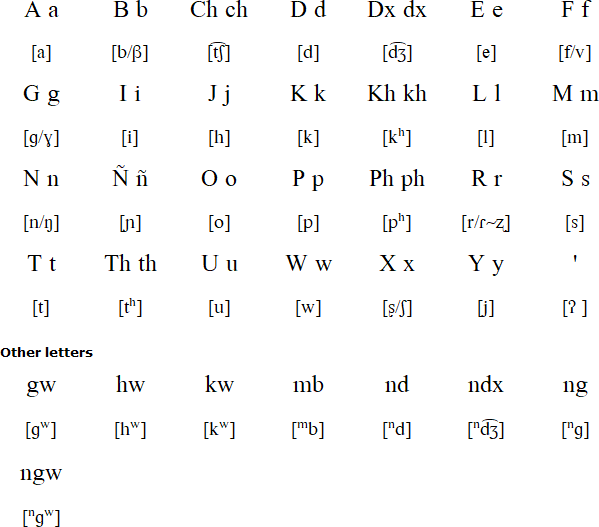Tlapanec is an Oto-Manguean language spoken by about 150,000 people mainly in the state of Guerrero in southern Mexico. There are also some Tlapanec speakers in the town of Chinameca in the state of Morelos, in Mexico City and in the USA.
Tlapanec is also known as Tlappanec, tlapaneco or Me'phaa. Native speakers call themselves and their language Me̱ꞌpha̱a̱ [meʔpʰaː].
There are several different varieties of Tlapanec, which are classified in some sources as separate languages, each of which has a number of dialects. They include Acatepec, Malinaltepec (Me̱ꞌphaa Mañuwìín) and Tlacoapa. Acatepec has about 40,200 speakers and dialects include Acatepec proper, Huitzapula, Nanzintla, Teocuitlapa and Zapotitlán Tablas. Malinaltepec has about 37,500 speakers, and one dialect: Huehuetepec / Zilacayotitlán. Tlacoapa has about 7,500 speakers and two dialects: Tlacoapa proper and Tenamazapa. They are written with the Latin alphabet.
The Mexican Instituto Nacional de Lenguas Indígenas officially recognises the following Tlapanec languages: Acatepec, Azoyú, Malinaltepec, Tlacoapa, Nancintla, Teocuitlapa, Zapotitlán Tablas, Zilacayotitlá.
Malinaltepec is used on one local radio station in Guerrero, and also in literature and local government.

Download an alphabet chart for Tlapanec (Excel)
Náa kúwíi̱n xa̱bu̱ meꞌpa̱a̱ rígá mbaꞌa enii iñiiꞌ: rígá iñiiꞌ mu̱jmu̱ꞌ, rígá iñiiꞌ miꞌxá, rígá iñiiꞌ miꞌñuu, xúꞌkui-̱má rígá iñiiꞌ ixi̱ mangaa. Dí iñiiꞌ īxi̱ mbrutu xóo dí i̱ꞌwáꞌ iñiiꞌ; iñiiꞌ rígi̱ | xóo gújkúꞌ kaꞌnii ikaa. Mangaamá rígá iñuuꞌ ru̱bú. Mbá xúguííꞌ iñiiꞌ rígi̱ | najma̱a̱ náa jmbañúúꞌ xa̱bu̱ meꞌpa̱a̱. Xúꞌkui̱-má ikaa iñiiꞌ rígi̱ | nagúún rágu̱jua̱ xuáá, mangaa-má naꞌpu̱ | mangiin mú dí ségu̱jua̱.
Where the Meꞌpaa people live, there are different kinds of cultivated tubers: there is the yellow yucca, there is the white yucca, there is the purple yucca, and there is the “woody” yucca. The woody yucca is different from the other yuccas; this yucca is a bit hard. There are also the chayote tubers. All of these cultivated tubers are found in the region of the Meꞌpaa people. They take these tubers to market to sell or they themselves eat them if they do not sell them.
Source: The sounds of Acatepec Me'paa (Tlapanec)
Information about Tlapanec | Numbers (Malinaltepec)
Information about Tlapanec languages
https://en.wikipedia.org/wiki/Tlapanec_language
https://fr.wikipedia.org/wiki/Tlapanèque
https://es.wikipedia.org/wiki/Idioma_tlapaneco
https://www.sil.org/resources/search/language/tpx
http://www.native-languages.org/tlapanec.htm
Chinanteco, Chatino, Mazahua, Mazatec, Mazatec (Chiquihuitlán), Mazatec (Jalapa), Mixtec, Mixtec (Chayuco), Mixtec (Coatzospan), Otomi, Otomi (Acazulco), Otomi (Sierra), Otomi (Temoaya), Tlapanec, Triqui (Chicahuaxtla), Triqui (Copala), Triqui (San Martín Itunyos), Triqui (Santo Domingo del Estero), Zapotec (Aloápam), Zapotec (Choápam), Zapotec (Güilá), Zapotec (Isthmus), Zapotec (Miahuatlán), Zapotec (Rincón), Zapotec (San Dionisio Ocotepec), Zapotec (Zoogocho)
Languages written with the Latin alphabet
Page last modified: 16.01.24
[top]
You can support this site by Buying Me A Coffee, and if you like what you see on this page, you can use the buttons below to share it with people you know.

If you like this site and find it useful, you can support it by making a donation via PayPal or Patreon, or by contributing in other ways. Omniglot is how I make my living.
Note: all links on this site to Amazon.com, Amazon.co.uk
and Amazon.fr
are affiliate links. This means I earn a commission if you click on any of them and buy something. So by clicking on these links you can help to support this site.
[top]